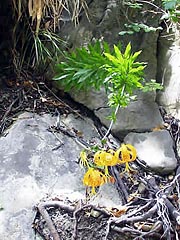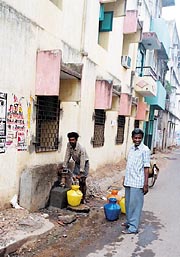
Whether it be the Koran – “By means of water we give life to everything;” or the wisdom of Lao-tzu – “Water is good; it benefits all things and does not compete with them;” or the Old Testament – “And the Spirit of God moved upon the face of the waters;” the imagery of water is a strong and satisfying one; its symbolism shared by the great religions – a powerful vision of the innumerable tributaries of life and hope.
Yet we all know that this has not resolved the world’s shortage of clean water, nor prevented bitter conflicts over how it is shared. Those waters have too frequently been far from still. Water is our life and our future, and only if we understand the real water scarcity that we face will we identify ways to ensure clean water for everyone.
This future will be one shared, no matter our desire – and it will be either a gratifying success or a nightmare of conflict. Anyone familiar with the history of the American West is familiar with the mayhem likely to be caused by disputed water rights. The 19th-century American humorist, Mark Twain, captured it well when he said, “Whiskey is for drinking, water is for fighting over.”
This must not be the case in the 21st century. In order to avoid the inherent dangers, we must recognize the critical need and properly manage the shared opportunity. In this context, good business and re-sponsible citizenship are mutually supportive. We are shareholders not only in our businesses, but in our global water future as well; and we must hold ourselves accountable in equal measure for both.

The Need and The Required Commitments
A brief look at global water availability and risks is a sobering one. We have been using and wasting water in ever-greater quantities. Clearly, the following trends cannot continue:
- Since 1900, there has been a six-fold increase in water use for only twice the population size. As a result, there now is no access to safe drinking water for one-fifth of the world’s population. And, water use by industry will re-double by 2025. Without action, industrial pollution will quadruple.
- Irrigation has increased 60 percent since 1960, with serious consequences. The Aral Sea, at one time the fourth largest inland body of water in the world, is a case in point. Thirty years of surface water takeoff has now depleted it to less than half its original size. Blowing toxic salts plague the area, along with growing soil salinity. In fact, because of seepage into the sub-soil, more than 20 percent of the world’s irrigated land is now salt-contaminated.
- 95 percent of the world’s cities still dump raw sewage into their waters. Shockingly, the list includes Brussels, home to the European Community, and Milan, the industrial center of Italy. One-half of all people do not have adequate water sanitation and, as a result, more than 5 million people die each year from causes related to unsanitary water.
While the realities and implications of global warming still are under debate, about water there is no debate: Serious degradation of our waters and critical shortages are indisputably occurring all around us – and are getting worse.
Whether as stakeholders in the community of man, or as shareholders in our businesses, anyone looking at world water trends has to be concerned and needs to make effective water management a priority. If the world is to prosper, we must meet the water needs of all. This means providing safe drinking water for our people, as well as supplying agriculture and industry.
With the future of water – and its life-sustaining properties – so clearly in question, what should be done? Let’s look at certain enabling processes that we recommend that would drive major improvement.

Creating a Water Market
There is no doubt that water represents economic capital and that such capital must be managed. Our supply of water is finite and the demand for it is burgeoning. Limited supply with increasing demand suggests the value of markets.A water market is a means for placing a proper value on this resource and for providing the economic incentives to move water from applications of lower value (and often misuse) to areas of higher value, with benefit to both.
Conservationists, who have long warned of undervaluing natural resources, support such a market enthusiastically. A professor at the University of California summed it up this way: This is not just (about) what’s sold – the more important role is that everyone will know what the water is worth. Then a farmer can compare the cost of conservation.
Knowing the value of water will discourage degradation, pollution and waste. The emergence of water markets and electronic trading, supported by “green” economists and businesspeople alike, is good news for all of us as we consider the future.
Remember that until recently there was no such thing as an energy market where wholesale electric power could be bought and sold. No one now doubts the benefits of energy as a commodity. Energy conservation has increased and with it energy supply. And prices have stabilized. Is water somehow exempt from such processes and benefits?
Water Productivity
We all are quite comfortable with the concept of land productivity. Crop yields have increased by using land productivity as a goal. The “Green Revolution” has been a land-productivity success story. The yield per unit of land has increased dramatically through planning and application of new techniques.Similar planning and new techniques are needed for our newer concept of water productivity. We must look to increase the yield per unit of water used, just as we look to increase the yield per unit of land used. Water must be managed for maximum yield. It makes so much sense, yet is so little considered. And, this concept of “water process yield” can be applied to industrial users, as well as to agri-business.
A water market provides economic incentives to improve water yield management, resulting in added efficiencies, improvements in quality, and benefits for new as well as traditional users.
In agri-business, for example, canals can be lined to eliminate seepage, drip irrigation can replace flood or spray schemes, and laser leveling of fields can make water distribution more efficient, while improved distribution systems and equipment can dramatically reduce energy consumption. Major industrial users of water can apply similar improvements.
We believe that water markets combined with the concept of water productivity would have benefits as significant as the Green Revolution. But it must first gain public acceptance.
Helen Keller was a woman who lived totally blind and deaf and mute, at one time understanding neither language nor communication. Until one day, a marvelous teacher placed her hands under the discharge of a water pump. At that moment her life was changed forever. In her own words: “The mystery of language was revealed to me. I knew then that ‘w-a-t-e-r’ meant the wonderful cool something that was flowing over my hand. That living word awakened my soul, gave it light, joy, set it free!”
If the 20th century offered the essential knowledge of the importance of clean, healthy water and the means to deliver it, so must the 21st provide the will and the means to make its availability a reality for the entire world.
It is time to resolve this most fundamental task. No grandiose projects of engineering are necessary to accomplish this crucial goal. No conquests of the physical laws or of national boundaries are required. Instead, we must merely take certain sensible, prosaic steps in order to change significantly for the better the world in which we live.
Water unites the world in an eternal hydrologic cycle; our oceans circle the globe, seeding the clouds that envelop our planet and feed its rivers. Water symbolically unites our religions in rites of birth, purification and re-birth, and of life itself.
Just as the religions of the world often look to the simple to explain the complex, so too the simple steps that have been described here can result in remarkable improvements in this moment of time for the many yet to come.
Report Abusive Comment